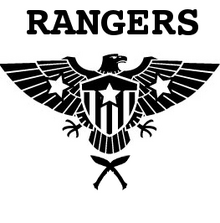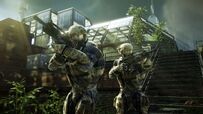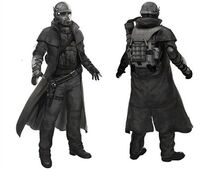"The average Ranger has probably killed twice, if not three or four times as many people out there than the average Spetsnaz jackboot could ever hope to...not for any sort of mission; just for survival in those Outlands they consider 'home'. They carry the "survival instinct" better than anyone. That's why you scatter 'em like jacks behind enemy lines. They come back with the results you're looking for every time."
-Sam Henshaw, Chief of the Imperial Ranger Corps

The simplistic logo and badge of the Rangers features nothing more than their title in a plain font, the Imperial crest, and a small pair of crossed kukri blades.
Introduction[]
The Imperial Ranger Corps (often simply referred to as the "Rangers") are a specialized branch of the Imperial Military specializing in reconnaissance, long-range patrol, and special operations. They are considered the foremost special forces group within the Imperial military, and unlike other elite formations (such as the Army Corps' Black Caps or the Vanguards' Dragoons), are not aligned to any one branch; instead existing as a separate branch, allowing it's troops to operate unhindered by anyone save the Grand Marshal.
Highly-skilled, highly-motivated, and given full reign of some of the most advanced technologies ever seen, the Rangers are often considered the most elite troops on any modern battlefield, capable of going toe-to-toe with anything from a Commonwealth shock trooper to a Mecharussian GRU without fear.
The most notable aspect of "Ranger culture", however, is the amount of time spent "vacationing" in the wastelands of the Empire and the wider world, often alone and with only as much supplies that can fit in their packs. The tradition stems from the first Rangers who fought in Hightower's Rebellion; the Gurkhas and the various ex-international special forces units that prowled the wastelands, waging guerilla warfare while living off the land. They will spend months at a time in the Outlands, relying on nothing but their combat skills and survival training. Aside from recording their findings on the state of the Outlands, they often lend a hand to the unfortunate denizens of these wasteland communities by killing off raiders or aggressive wildlife, requesting supply drops from nearby outposts to feed the starving, and other such actions that could be considered "humanitarian missions." These good deeds are thought to deter the wastelanders from open resistance against the Empire (which did indeed happen, leading to the Red Revolt after the Mechanocracy implanted populists into the Frenkish wilderness).
History[]
Training and Equipment[]
Ranger training is notoriously brutal for those hoping to directly join, with over 90% of all recruits dropping out prior to the first three days (named "Hell's First Three" by graduated Rangers). These first few days include intense physical and mental conditioning, and is meant not necessarily to train applicants to be Rangers, but is instead designed to test their willpower. The Hell's First Three includes various fits of intense activity, however, the most infamous of these strenuous "challenges" is the "simulated interrogation". Here, instructors pose as hostile interrogators (often bringing in actual Russian, Asian, or Islamic defectors who might have specialized in work of this caliber to make it seem more real) and force the recruit to undergo an entire night of torture of various forms. Recruits are put through intense, near-realistic forms of torture for one thing; a codeword given to them shortly before by their drill instructor, along with a last-minute drill of resistance against torture. Saying the codeword will end the interrogation right at that second, but will also mean the end of their prospect of becoming a Ranger. Despite regulations on the torturer (no crippling or scarring injuries, no overly invasive sexual methods, must keep a firm watch on the recruit's physical and mental vitals, etc) and the promise of the worst of it being over after that night, almost 50% of all rejects cite the interrogation as their breaking point. Assuming the recruit makes it through, they are checked for signs of mental trauma and allowed to continue on with training, with it often considered much more forgiving after that point.
Recruits taken from other military units (which is often the case, as most special forces groups consider it a "promotion" to become a Ranger) do not have to go through the Hell's First Three, seeing as other units typically have their own tests of willpower and endurance. The final night is instead replaced with a much more tame "interrogation resistance" course.
After the Hell's First Three, they learn many skills throughout this period. Particularly in combat, Rangers are trained to fight fast and ferociously, utilizing the environment around them (making them excellent in unconventional warfare) and whatever tools at their disposal to achieve victory at whatever cost. To hammer this home, Rangers are trained to use any firearm, directed energy weapon, or object as skillfully as possible. From broken bottles to antiquated bolt-action sniper rifles to Mecharussian Ion blasters, Rangers are expected to succeed with any weapon. A common saying claims that "the best Army sniper is only an average shot next to a Ranger who brings a shotgun".
Rangers also train in survival at various wasteland camps. There, they learn all the necessary techniques; hunting, foraging, first aid, and shelter. Rangers are instructed in various forms of biology to aid with the wasteland wildlife (such as identification of plants that could be helpful or dangerous, how to easily pacify or neutralize agitated animals, etc), as well as mutalogy to better respond to radiation and the mutants it spawned. Evasion is also gone over, and how their survival training will better adapt them to their duties in reconnaissance and unconventional warfare. Training trips are even made to Siberia on occasion to emphasize this.
Aside from their enhanced infantry and survival training, they learn advanced martial arts techniques (usually Bando, and more often than not trained in using one-handed melee weaponry in this fashion, making them that much deadlier with their kukris), mountaineering, scuba diving, basic flying, weapon maintenance, various languages (often Russian, Mandarin, and Arabic, among others), hostage rescue, and crisis negotiation among many others. This makes one lone Ranger self-sufficient, no matter the situation.

Rangers in their N1 nanosuits; "tactical mode"
Augmentation is the last (and possibly most important) aspect of training. While very few Rangers could be considered cyborgs (what few there are likely made such due to injuries in the line of duty), they make use of some of the most advanced armor technology ever conceived; the N1 Nanosuit. The armor (yet to be perfected) is highly unstable to those untrained in it's use, and can have a myriad of unpredictable reactions when presented with too many variables. For example, if the suit becomes too damaged, the environmental augmentation scrubbers will begin breaking down the closest source of matter to repair itself, and that almost means the wearer. When this happens, it often means that removal of the suit will mean death. If worn too long, the suit can actually begin fusing to the skin, also making it impossible to remove. Since the wearer also needs to be naked when suiting up to ensure proper nerve connections, making good hygiene is a necessity. Rangers often shave their entire body to avoid snagging on the suit, save for the hair on their heads and (maybe) a small amount of facial hair for males. Even with good training and muscle technique, the suit is often considered too dangerous to wear on regular occasion, and as such, is only worn in operations, training exercises for said operations, and when performing reconnaissance in enemy territory (though in the case of the latter, it's usually held in reserve and deployed by the wearer only in emergencies; the patrol uniform is preferred out of combat). When wearing this uniform variation, Rangers are said to be in "tactical mode".

The common Ranger patrol uniform.
During wasteland exploration and patrol, Rangers typically favor a lightweight outfit equipped with a liquid-kevlar vest and light ceramic plating worn with a signature black duster and often paired with a face-obscuring helmet (the favorite being a pre-war riot helmet, which are scavenged in abundance from police stations and used because of their intimidating look and good performance). When wearing this, Rangers are considered to be in their "patrol uniform".
Rangers make use of a wide array of weaponry, pre-war weapons scavenged from the Outlands in times of desperation to advanced energy weapons to match their Mecharussian counterparts. Though they use pretty much any weapons in the Frenkish inventories, Rangers typically favor guns or energy weapons that are highly customizable to suit their various skills, along with something reliable enough to see them through the wasteland and battlefield alike. Assault rifles such as the M26 and SCAR are often issued (especially considering their SOPMOD variants easily support attachments such as suppressors), though more often than not, the PAX-IX system takes the cake due to the sheer versatility of the weapon. The Auto-9 and SS12 are favored sidearms.
Lastly (but certainly not least, in terms of it's significance to Ranger culture) is their signature Ranger kukri. Issued as a badge of office, the kukri is featured prominently where Rangers are involved. Worn and wielded in honor of the ten thousand Gurkhas who died in serving as Hightower's elite recon troops during his rebellion, these sleek machete knives have been modernized with nanotechnology, making them capable of cutting through most anything, making them an invaluable tool and even weapon should it ever be needed as such.
Notable Members[]
wip
Trivia[]
- The Imperial Ranger Corps is primarily based upon the NCR Rangers (seen in Fallout 2 and Fallout New Vegas); elite troops with a penchant for marksmanship, hand-to-hand combat, wilderness survival, and braving the wastes to hunt slavers and raiders.
